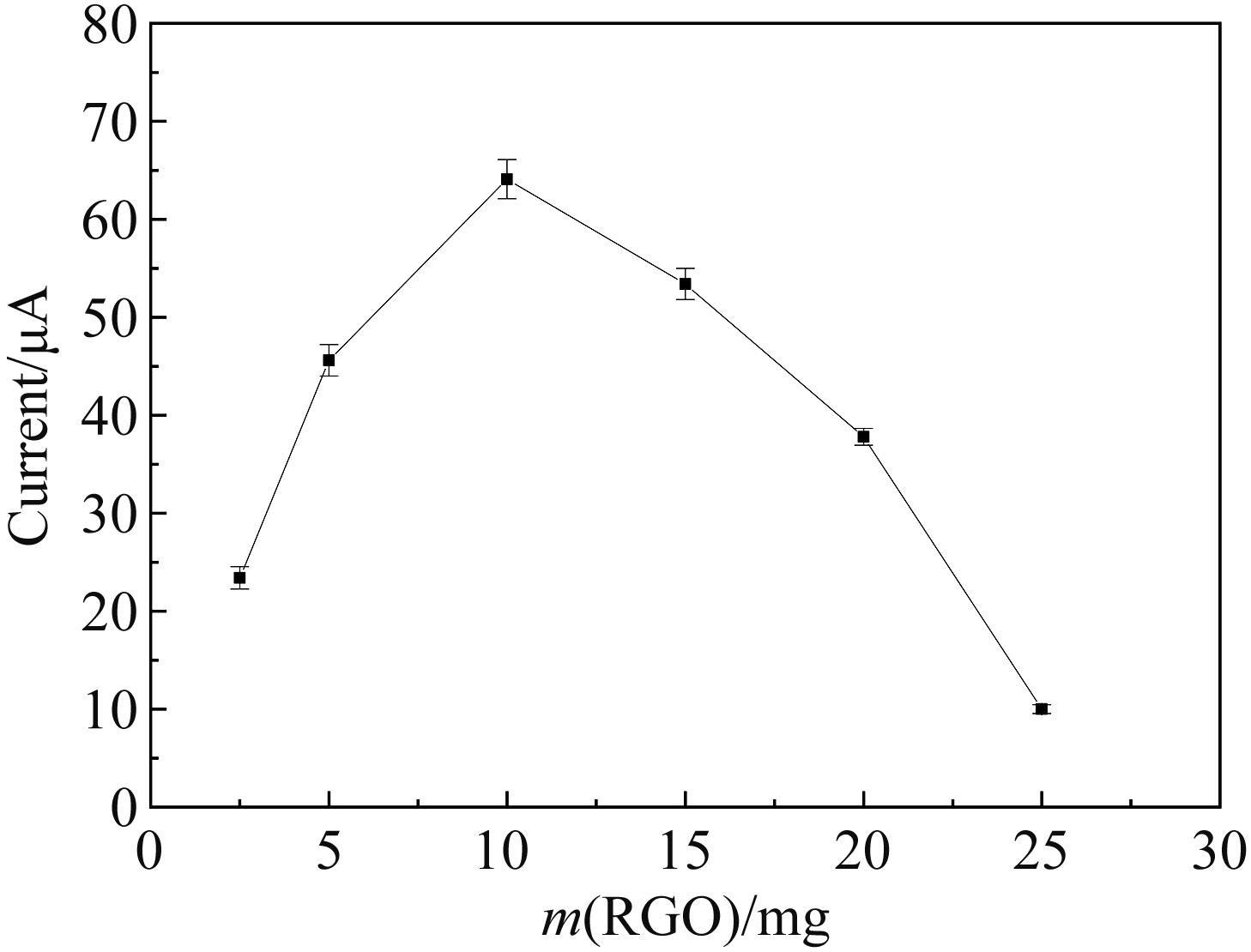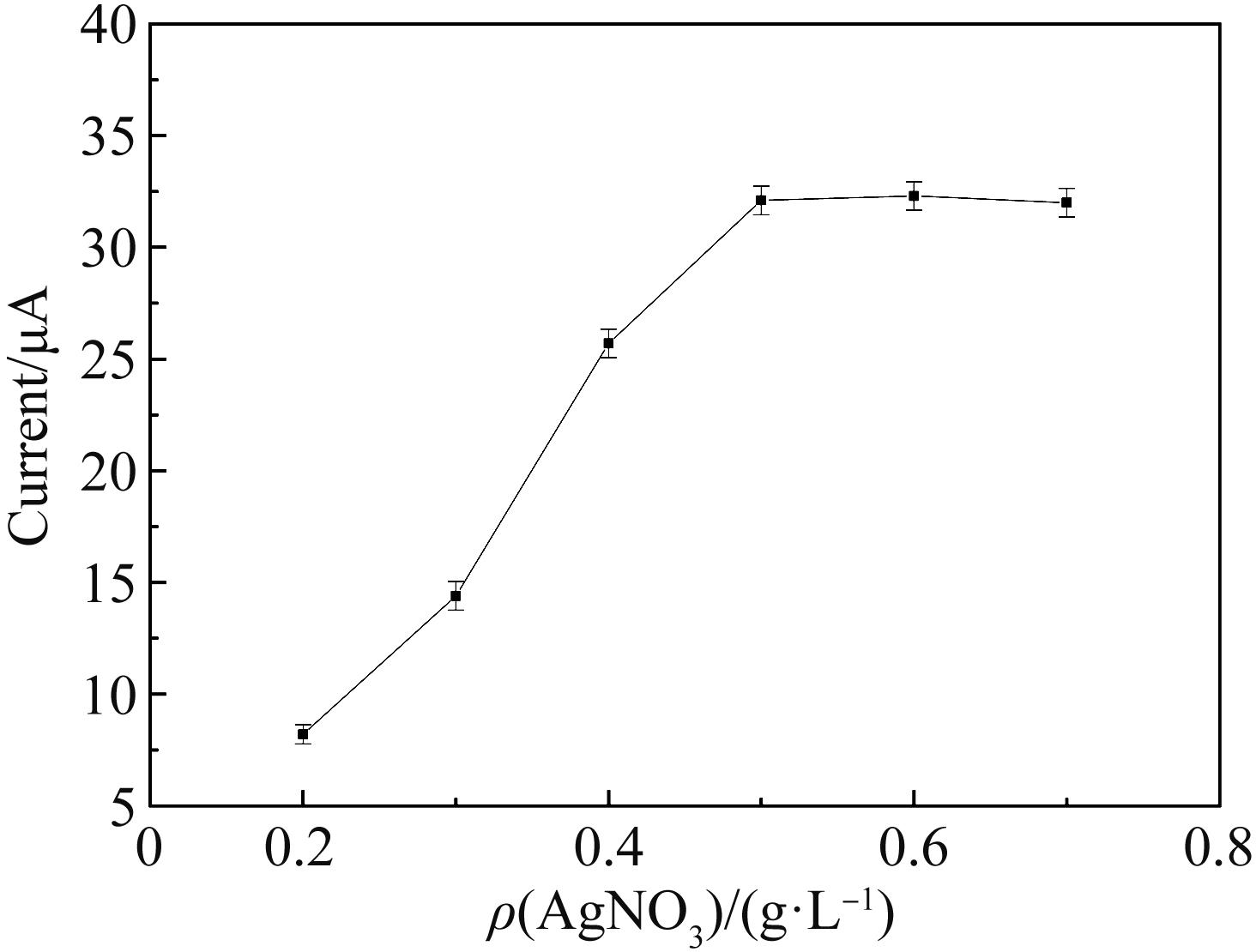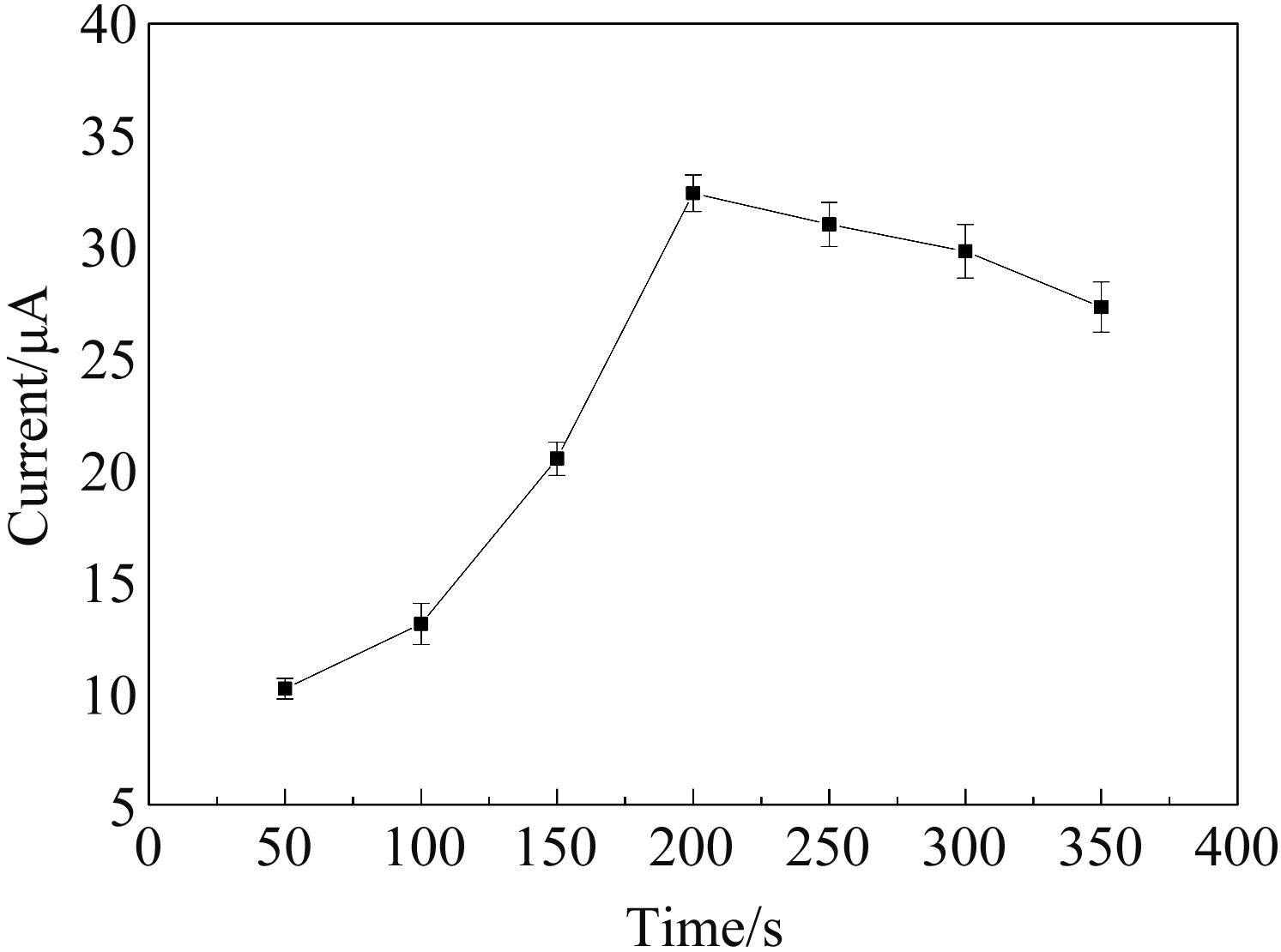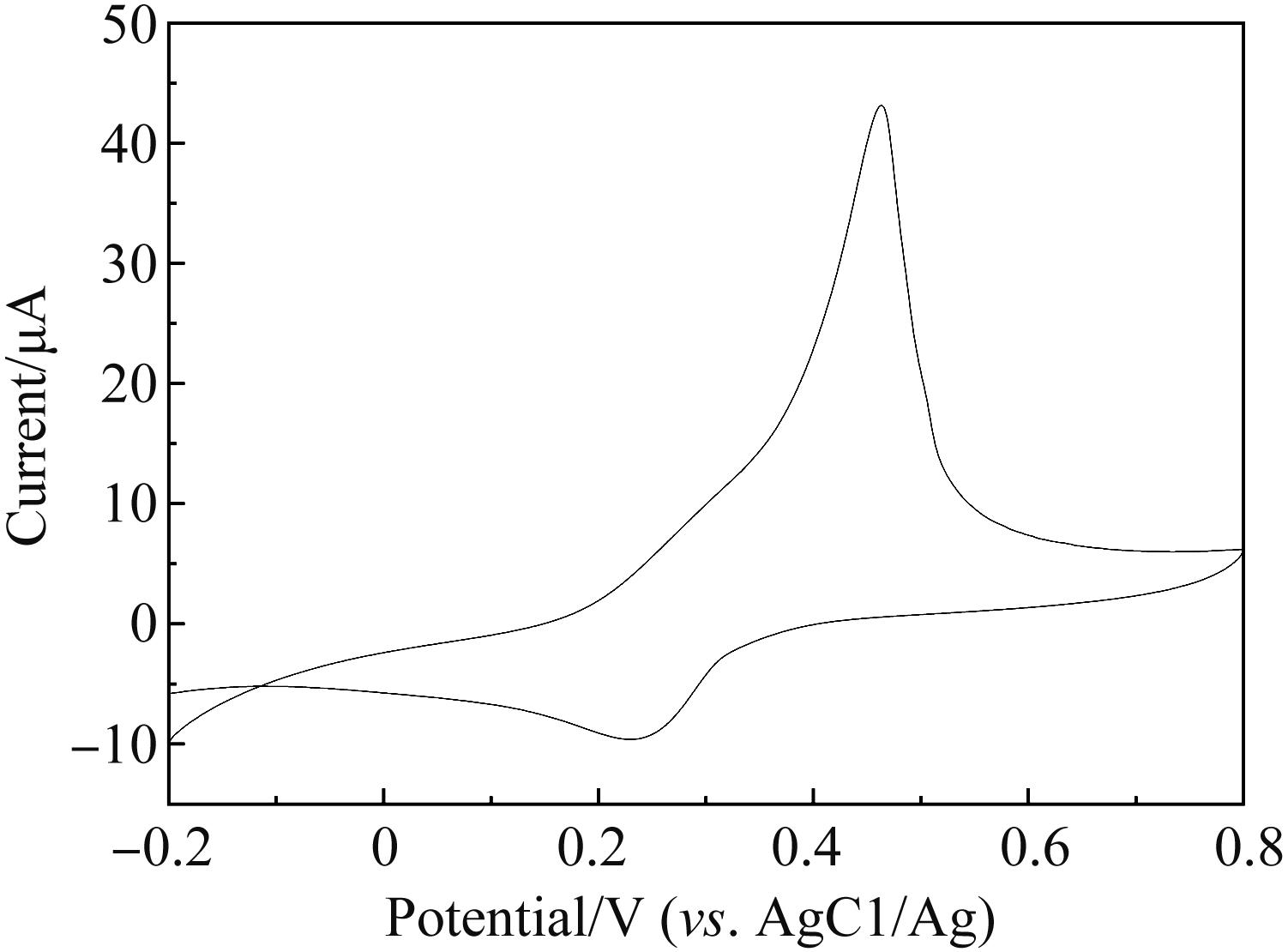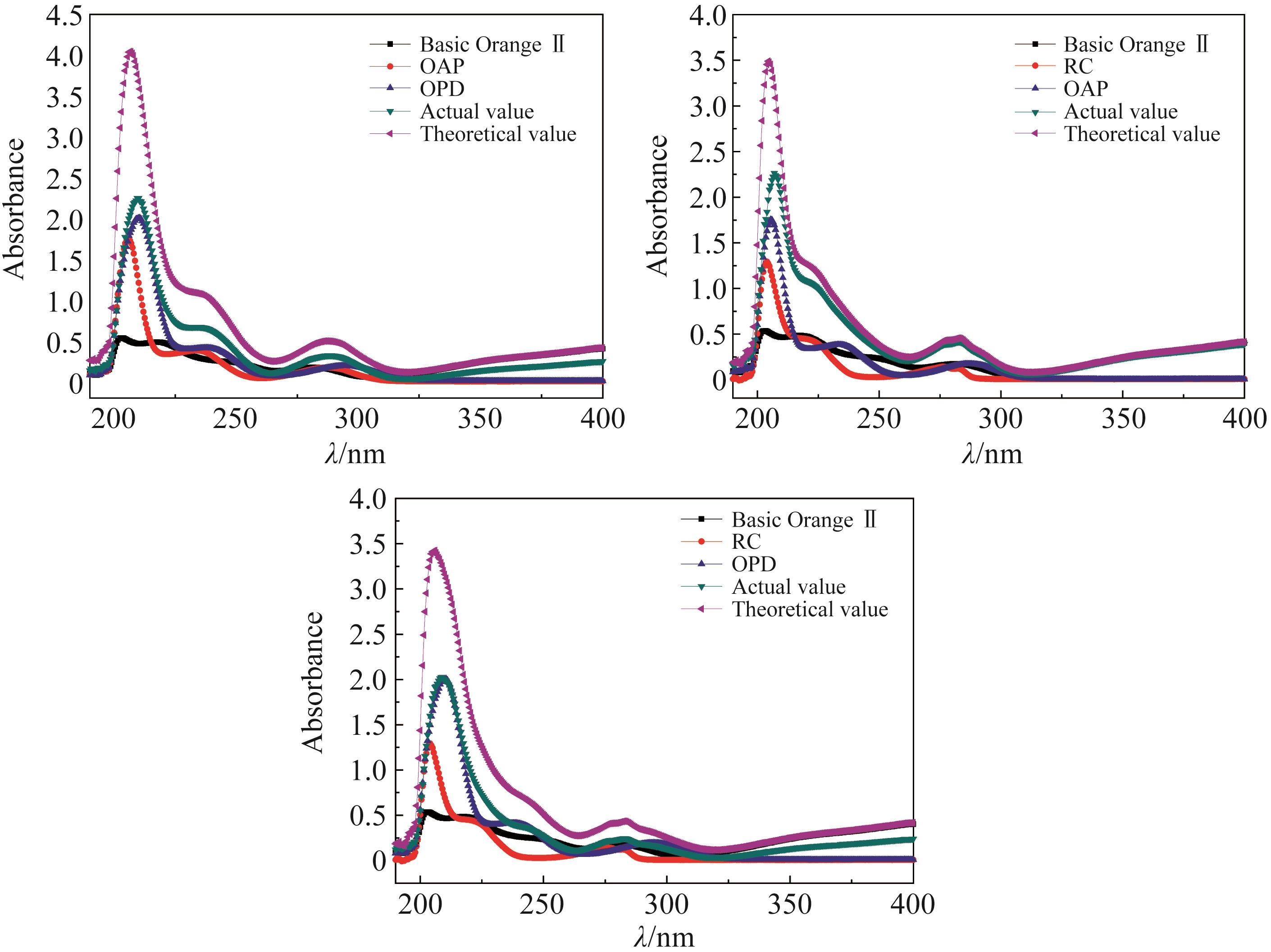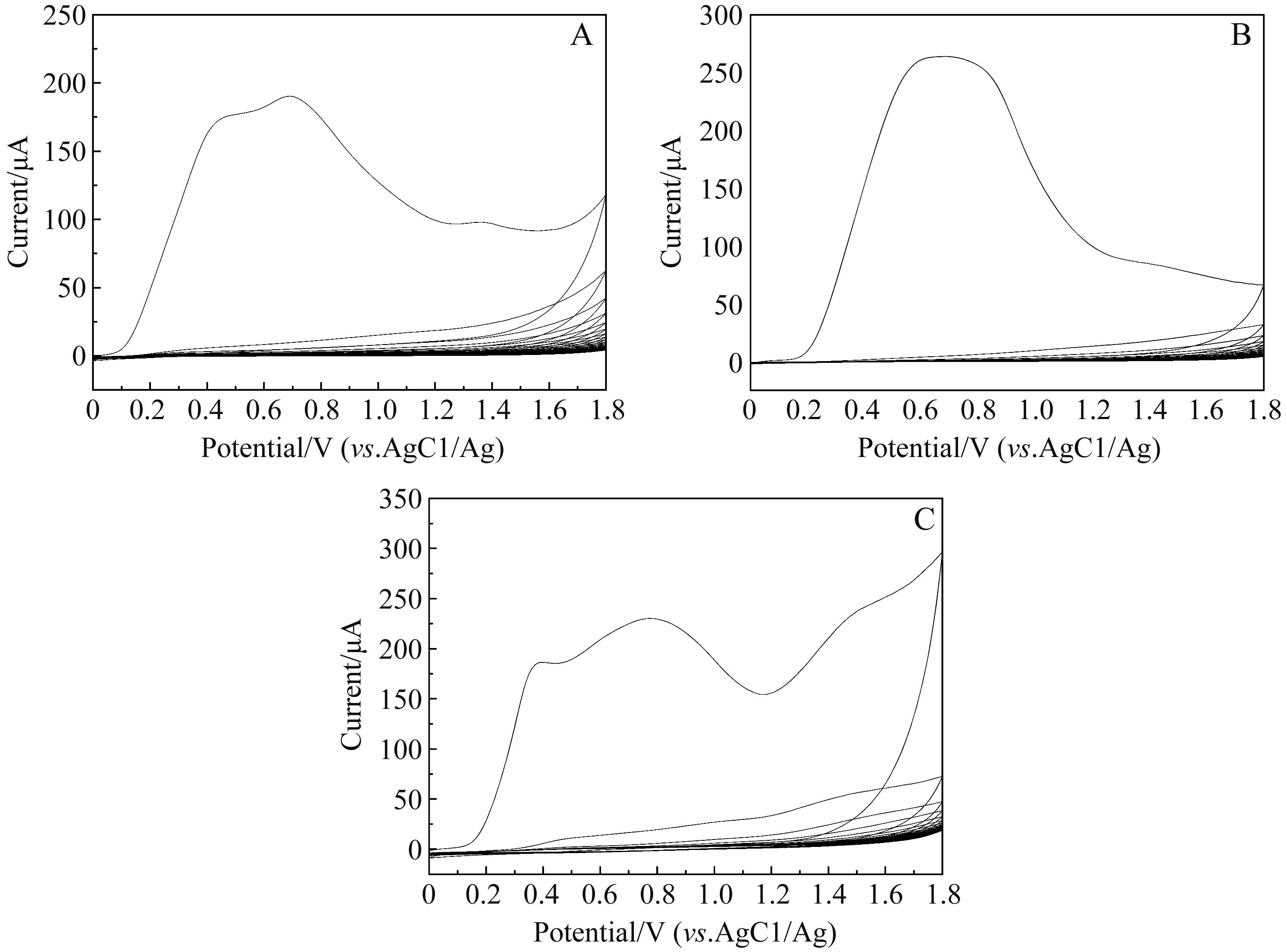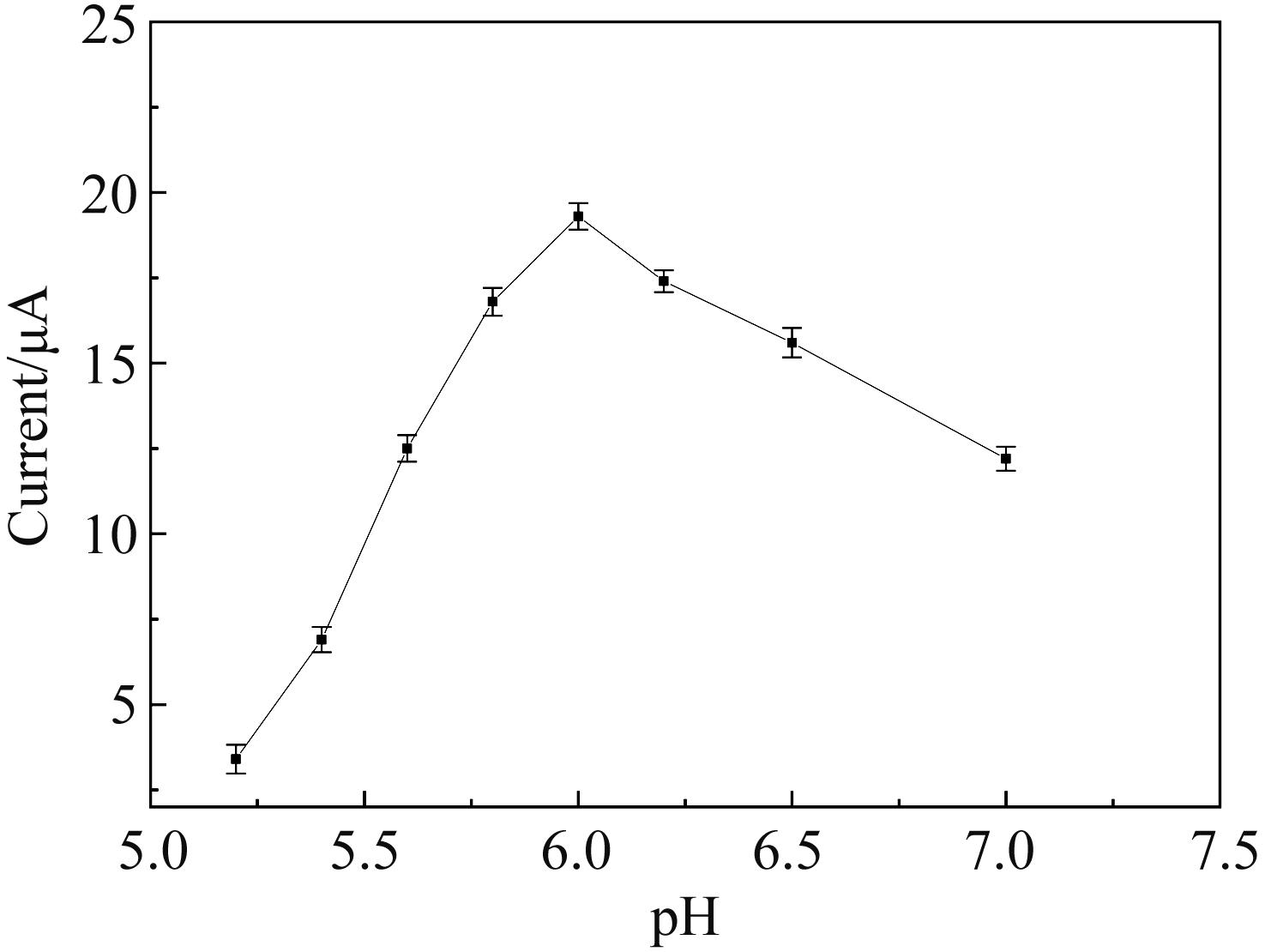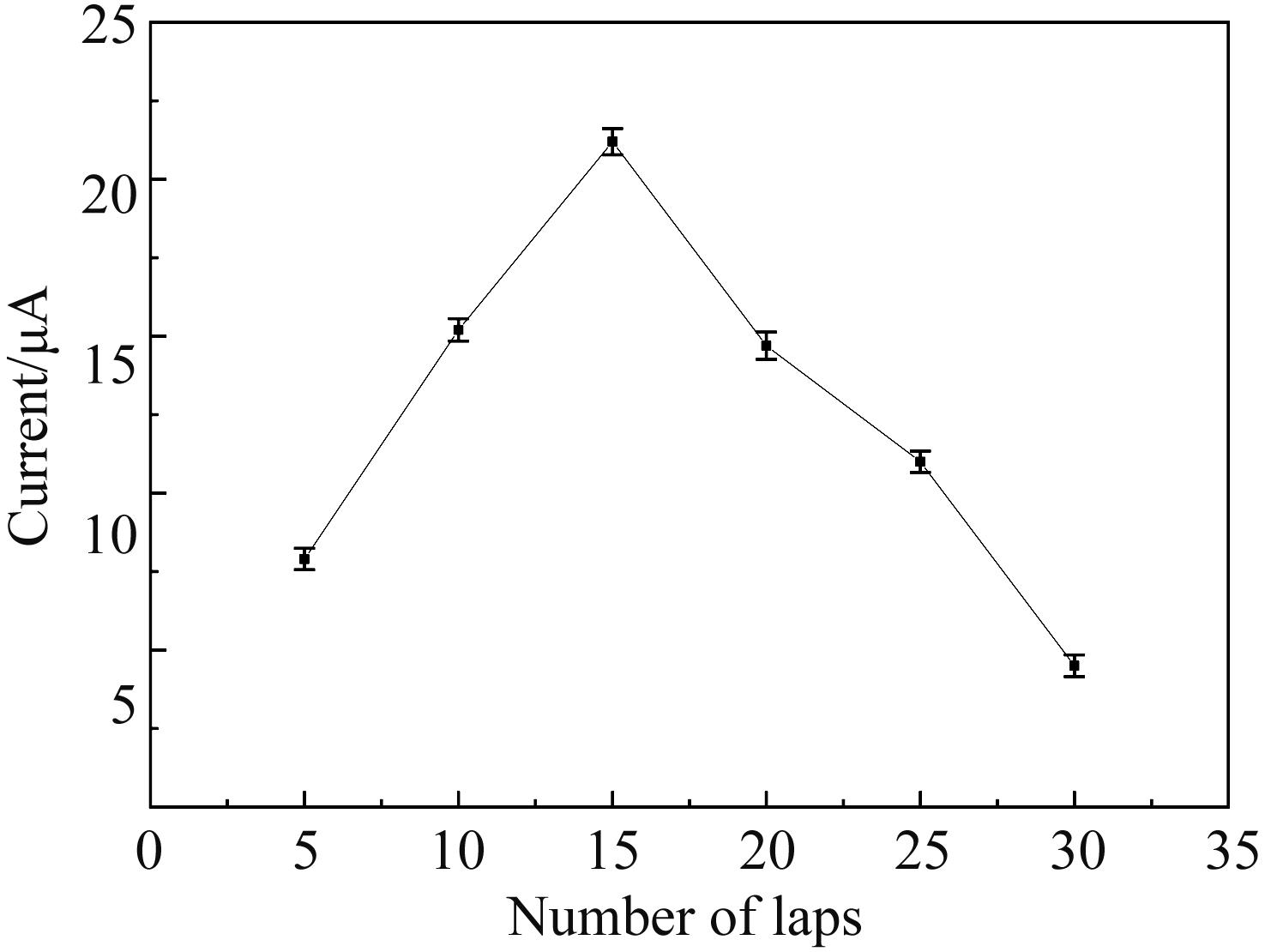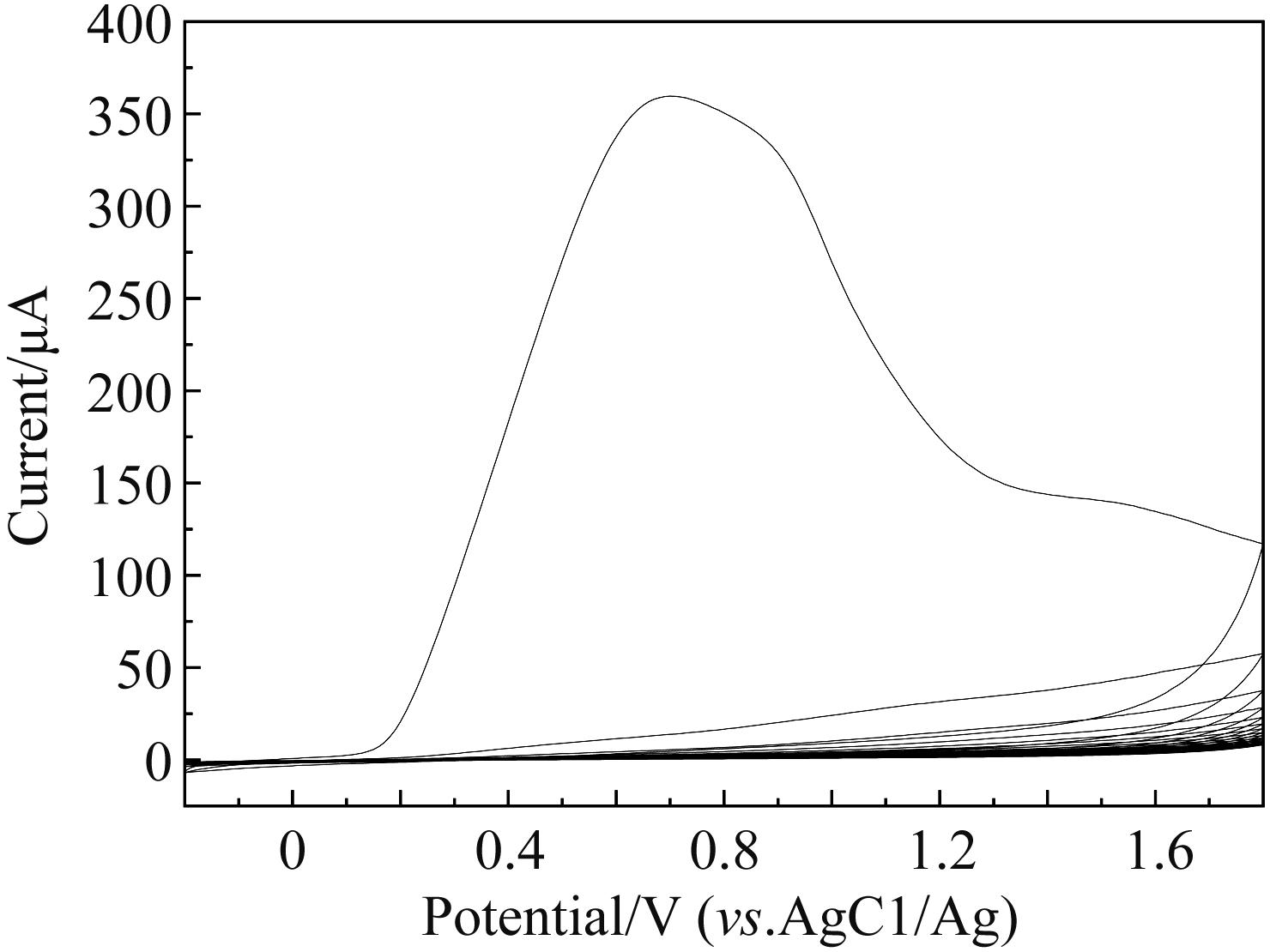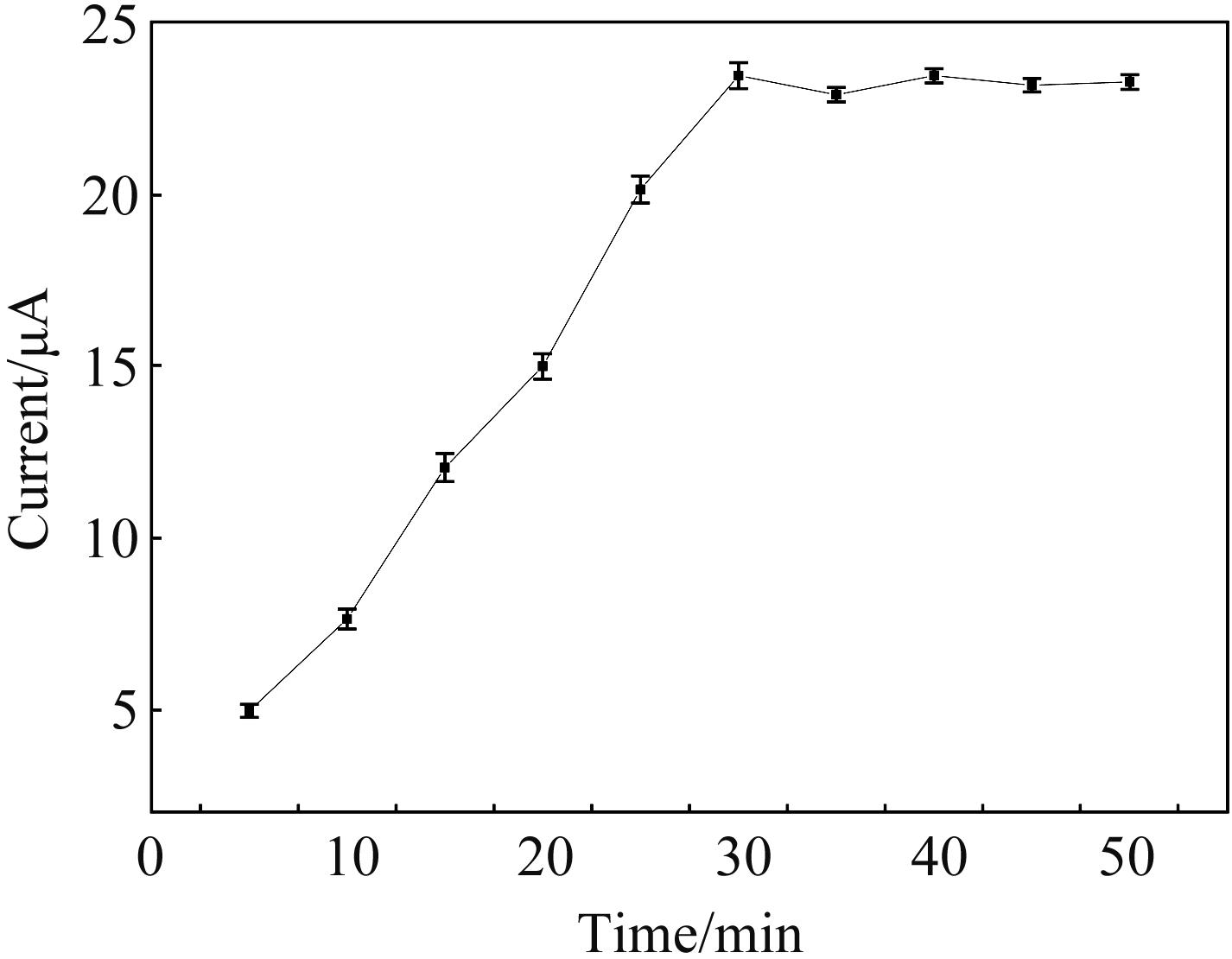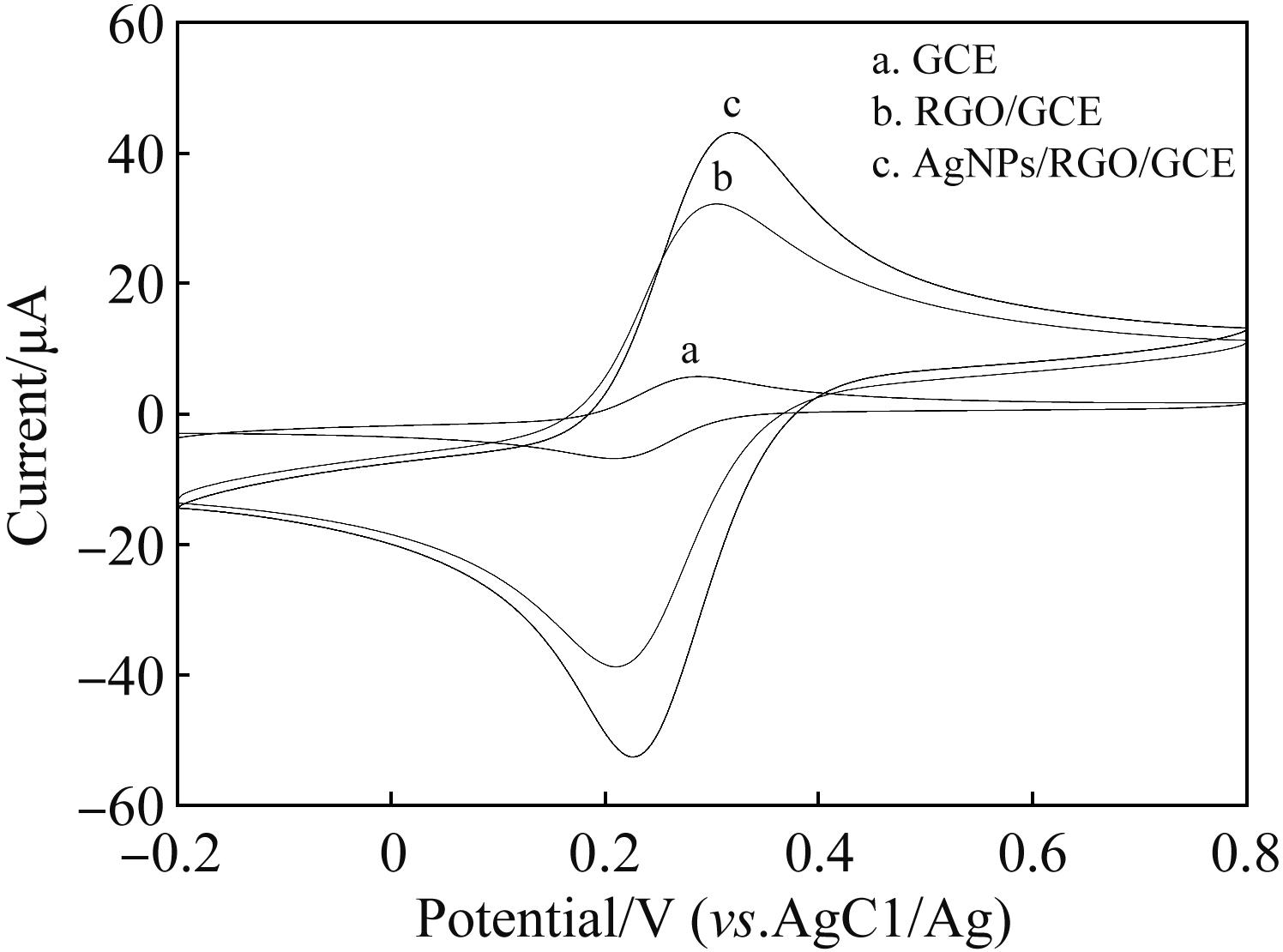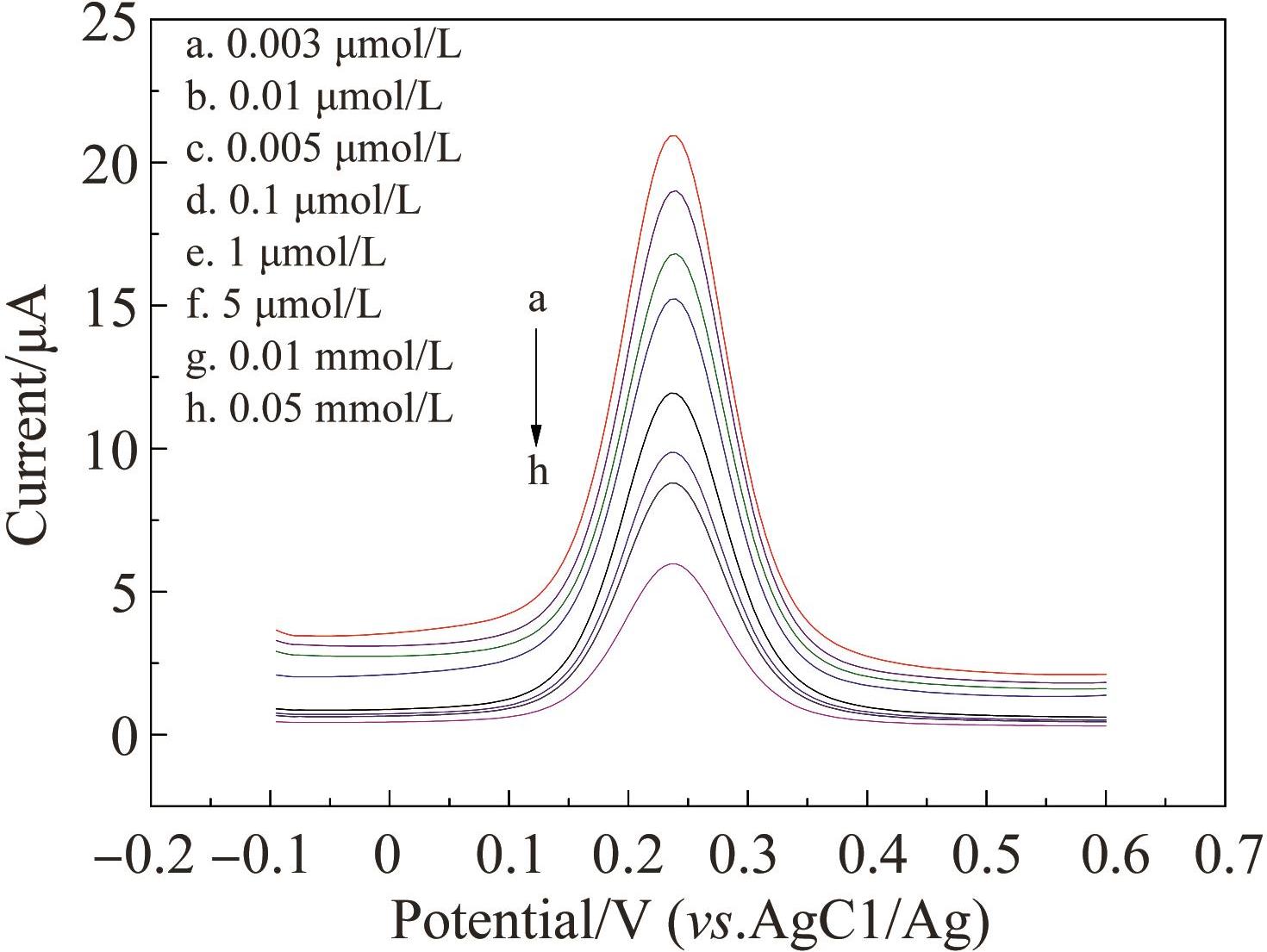
应用化学 ›› 2022, Vol. 39 ›› Issue (7): 1052-1064.DOI: 10.19894/j.issn.1000-0518.210164
碱性橙Ⅱ印迹传感器的制备及其应用
- 河北科技大学食品与生物学院,石家庄 050000
-
收稿日期:2021-04-06接受日期:2021-07-30出版日期:2022-07-01发布日期:2022-07-11 -
通讯作者:高文惠 -
基金资助:河北省硕士研究生创新资助项目(CXZZSS2021101);河北省重点研发计划项目(19275505D);石家庄市科技研发计划项目(211170183A)
Preparation and Application of Basic OrangeⅡImprinted Sensor
Dong-Dong LI, Li QIN, Lu-Hua TANG, Wen-Hui GAO( )
)
- College of Food and Biology,Hebei University of Science and Technology,Shijiazhuang 050000,China
-
Received:2021-04-06Accepted:2021-07-30Published:2022-07-01Online:2022-07-11 -
Contact:Wen-Hui GAO -
About author:wenhuigao@126.com
-
Supported by:the Postgraduate Innovation Funding Project of Hebei Province(CXZZSS2021101);the Key Research and Development Program Project of Hebei Province(19275505D);the Science and Technology Research and Development Plan Project of Shijiazhuang(211170183A)
摘要:
以纳米石墨烯和纳米银作为修饰材料修饰工作电极,制备一种以碱性橙Ⅱ为模板分子,邻氨基苯酚和邻苯二胺为复合功能单体的新型快速检测碱性橙Ⅱ的印迹传感器。运用紫外光谱法选择最佳功能单体,并研究了模板分子与功能单体之间的作用形式和作用强度,采用电化学分析法优化各种制备条件,用甲醇?0.4 mol/L NaOH水溶液(体积比2∶1)洗脱模板分子,得到分子印迹电极,并对印迹电极的分析性能进行了研究。实验结果表明,该印迹传感器对碱性橙Ⅱ具有高选择性,样品加标平均回收率为88.45%~101.40%,相对标准偏差(RSD)在1.31%~2.83%之间(n=5),线性范围为3.0×10-9~5.0×10-5 mol/L,检出限为1.0×10-9 mol/L。该传感器成功应用于食品中碱性橙Ⅱ残留的快速检测。
中图分类号:
引用本文
李东东, 秦丽, 唐录华, 高文惠. 碱性橙Ⅱ印迹传感器的制备及其应用[J]. 应用化学, 2022, 39(7): 1052-1064.
Dong-Dong LI, Li QIN, Lu-Hua TANG, Wen-Hui GAO. Preparation and Application of Basic OrangeⅡImprinted Sensor[J]. Chinese Journal of Applied Chemistry, 2022, 39(7): 1052-1064.
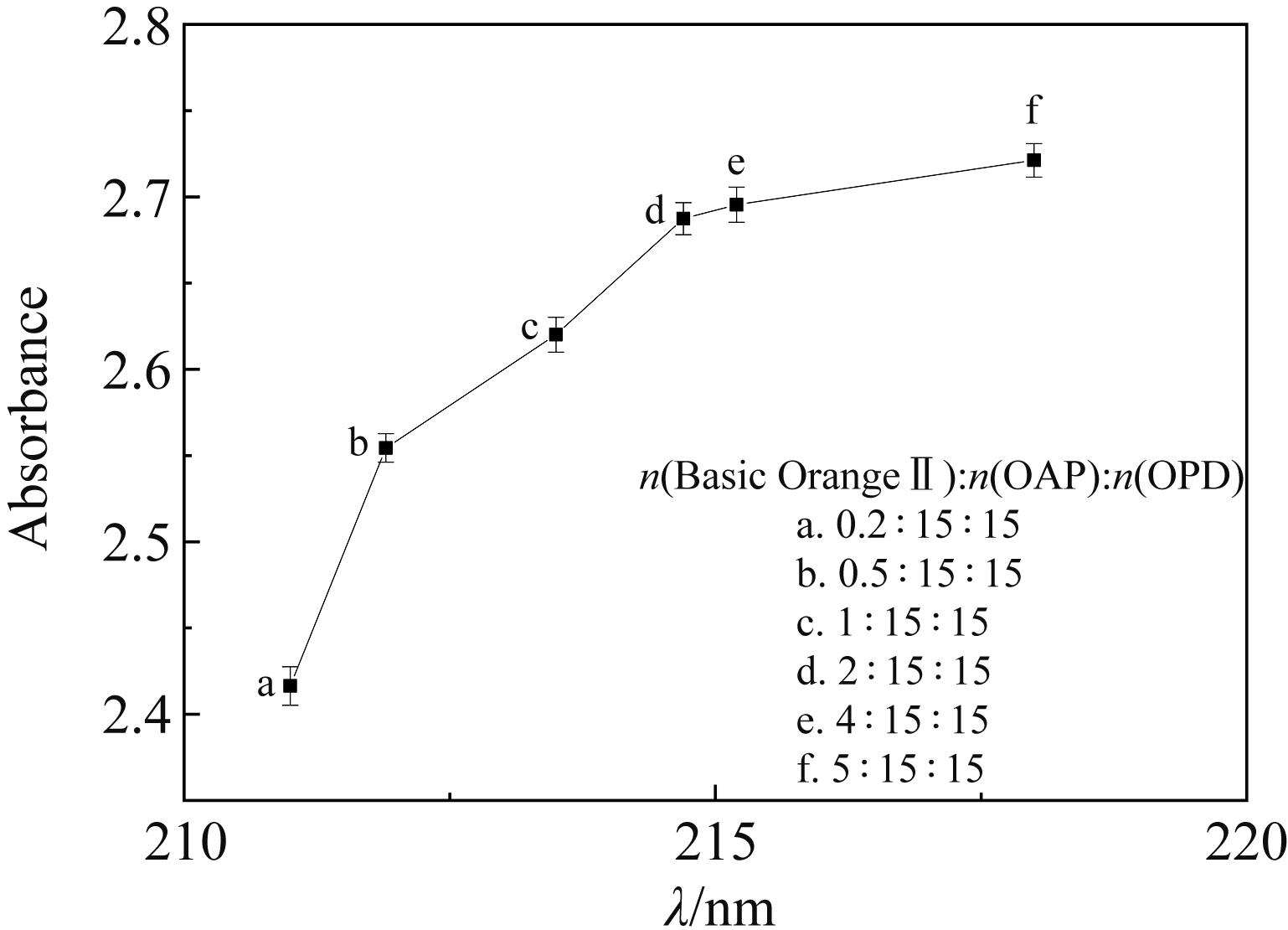
图7 不同浓度的模板分子和复合功能单体最大吸收波长与吸光值变化趋势
Fig.7 The variation trend of the maximum absorption wavelength and absorption value of template molecules and composite functional monomers with different concentrations
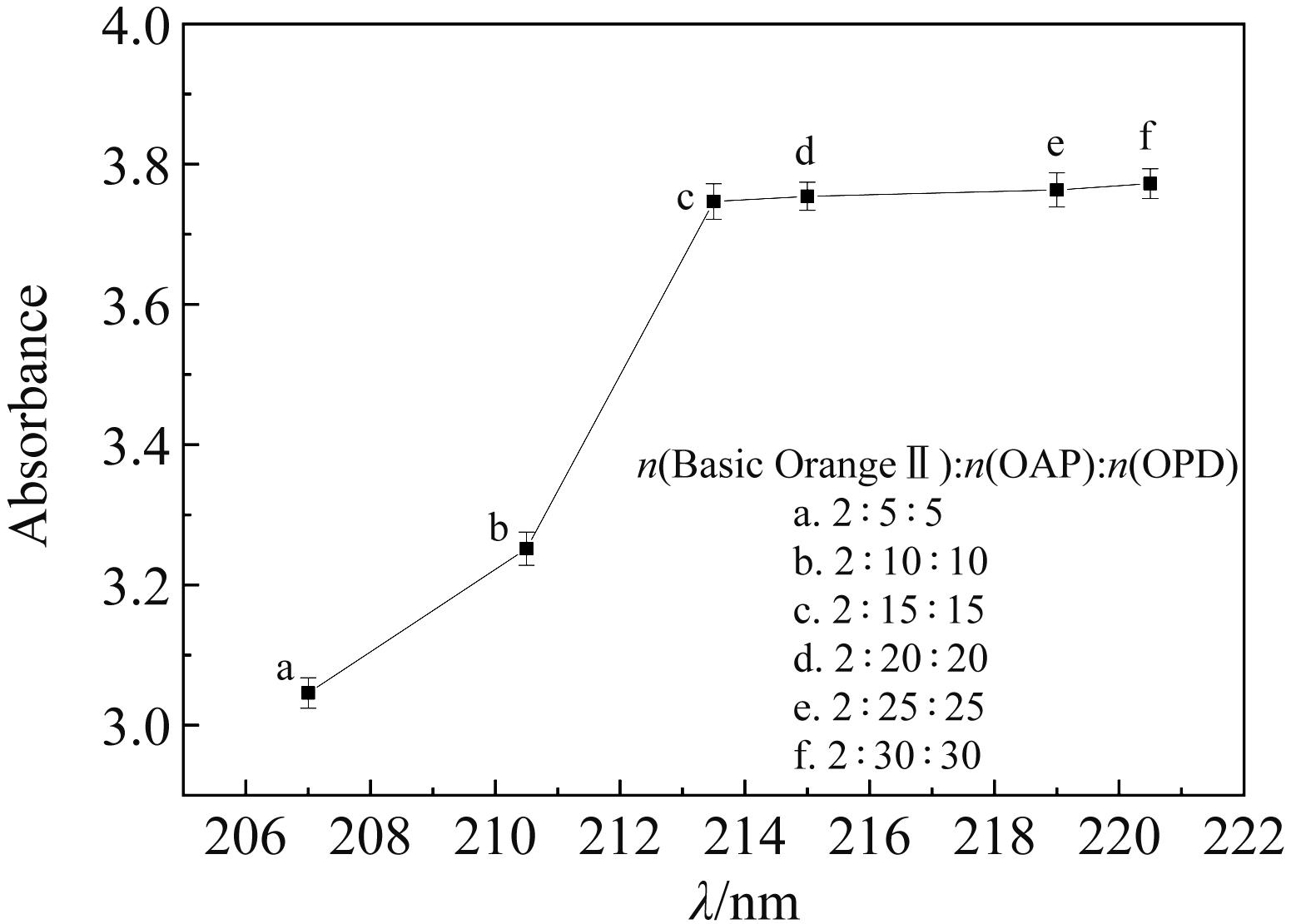
图8 模板分子与不同摩尔比的功能单体吸光值与最大吸收波长的关系曲线
Fig.8 The relationship between the absorption value and the maximum absorption wavelength of template molecules and different proportion of functional monomers
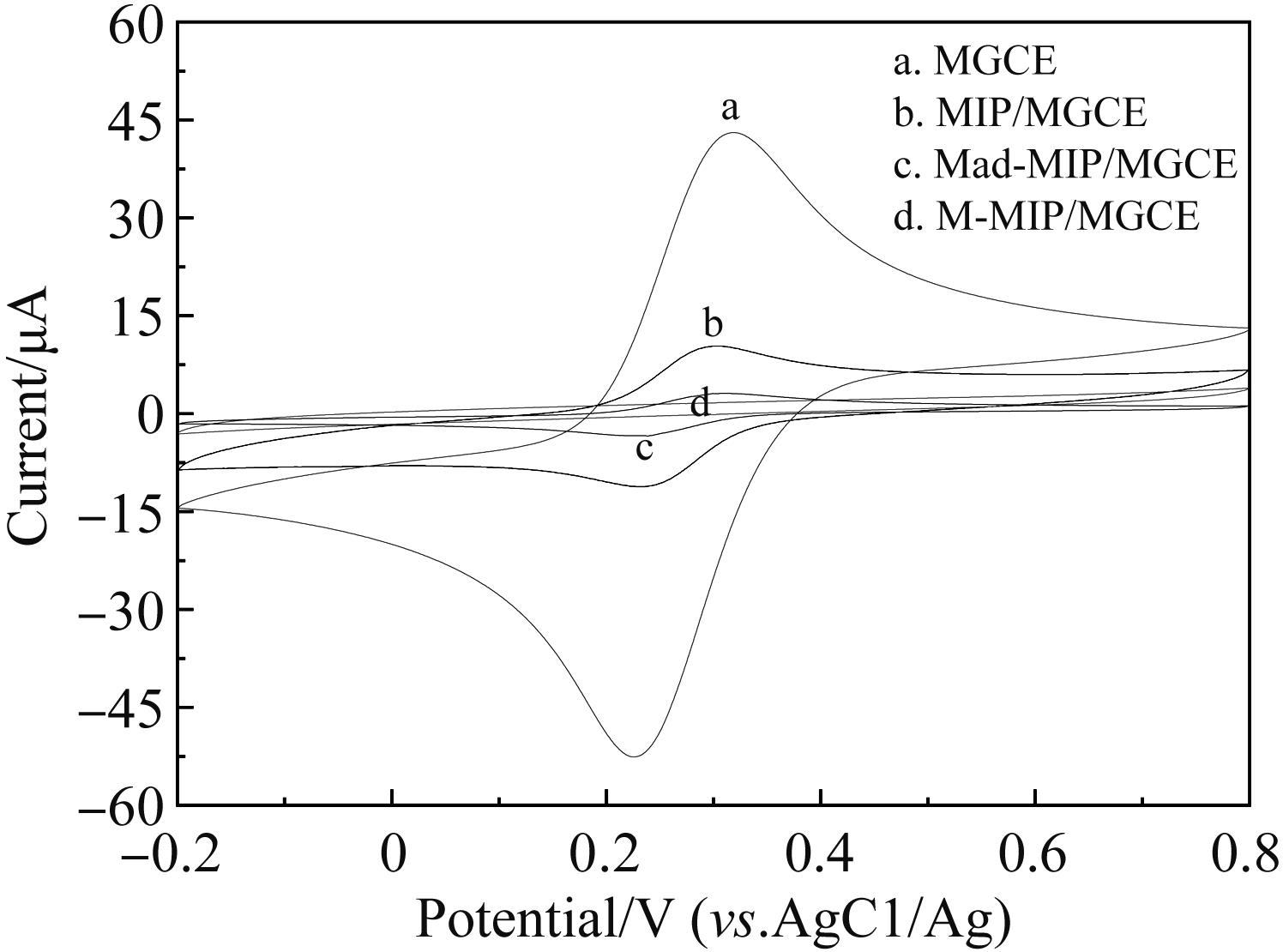
图15 不同电极在表征溶液中的CV曲线a.修饰后电极; b.洗脱后电极; c.吸附后电极;d.聚合后电极
Fig.15 CV curves of different electrodes in the characterization solutiona.MGCE; b.MIP/MGCE; c.Mad-MIP/MGCE;d.M-MIP/MGCE
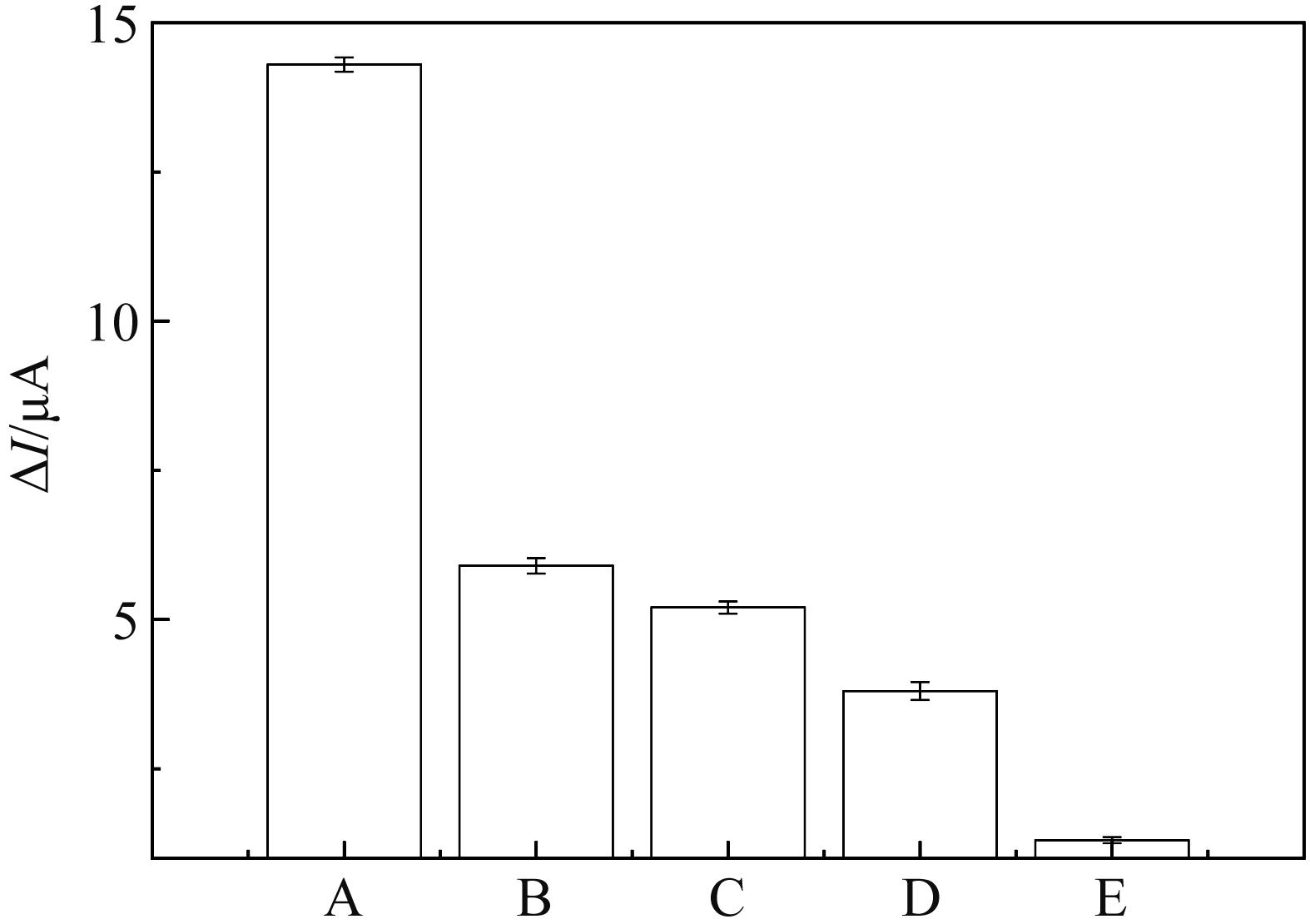
图16 印迹电极的选择性A.碱性橙Ⅱ; B.苏丹红Ⅰ; C.苏丹红Ⅱ; D:酸性橙Ⅱ; E.罗丹明B
Fig.16 Selectivity of the imprinted electrodeA.Basic orangeⅡ; B.SudanⅠ; C.SudanⅡ; D.Acid OrangeⅡ; E.Rhodamine B
样品 Sample | 辣椒面 Chili powder | 腐竹 Bean curd stick | 豆皮 Bean curd | ||||||
|---|---|---|---|---|---|---|---|---|---|
添加水平 Added levels/(mol·L-1) | 3.0×10-9 | 2.0×10-8 | 3×10-7 | 3.0×10-9 | 2.0×10-8 | 3×10-7 | 3.0×10-9 | 2.0×10-8 | 3×10-7 |
测定次数 Number of measurements | 回收率 Recovery/% | ||||||||
| 1 | 87.91 | 94.65 | 102.01 | 92.54 | 96.46 | 98.63 | 89.41 | 97.38 | 103.45 |
| 2 | 90.72 | 95.03 | 99.48 | 88.69 | 94.74 | 97.65 | 87.82 | 96.44 | 101.21 |
| 3 | 86.87 | 94.59 | 98.96 | 91.35 | 97.82 | 98.99 | 92.73 | 96.81 | 99.38 |
| 4 | 89.23 | 95.46 | 99.75 | 90.82 | 93.61 | 101.05 | 89.64 | 95.53 | 100.02 |
| 5 | 87.54 | 98.18 | 101.92 | 87.73 | 97.15 | 98.24 | 91.12 | 92.67 | 102.94 |
平均回收率 Average recovery/% | 88.45 | 95.58 | 100.42 | 90.23 | 95.96 | 98.91 | 90.14 | 95.77 | 101.40 |
相对标准偏差 RSD/% | 1.73 | 1.56 | 1.43 | 2.19 | 1.82 | 1.31 | 2.06 | 1.94 | 1.75 |
表1 辣椒面及豆制品的加标回收率和精密度(n=5)
Table 1 Recovery and precision of capsicum powder and bean products(n=5)
样品 Sample | 辣椒面 Chili powder | 腐竹 Bean curd stick | 豆皮 Bean curd | ||||||
|---|---|---|---|---|---|---|---|---|---|
添加水平 Added levels/(mol·L-1) | 3.0×10-9 | 2.0×10-8 | 3×10-7 | 3.0×10-9 | 2.0×10-8 | 3×10-7 | 3.0×10-9 | 2.0×10-8 | 3×10-7 |
测定次数 Number of measurements | 回收率 Recovery/% | ||||||||
| 1 | 87.91 | 94.65 | 102.01 | 92.54 | 96.46 | 98.63 | 89.41 | 97.38 | 103.45 |
| 2 | 90.72 | 95.03 | 99.48 | 88.69 | 94.74 | 97.65 | 87.82 | 96.44 | 101.21 |
| 3 | 86.87 | 94.59 | 98.96 | 91.35 | 97.82 | 98.99 | 92.73 | 96.81 | 99.38 |
| 4 | 89.23 | 95.46 | 99.75 | 90.82 | 93.61 | 101.05 | 89.64 | 95.53 | 100.02 |
| 5 | 87.54 | 98.18 | 101.92 | 87.73 | 97.15 | 98.24 | 91.12 | 92.67 | 102.94 |
平均回收率 Average recovery/% | 88.45 | 95.58 | 100.42 | 90.23 | 95.96 | 98.91 | 90.14 | 95.77 | 101.40 |
相对标准偏差 RSD/% | 1.73 | 1.56 | 1.43 | 2.19 | 1.82 | 1.31 | 2.06 | 1.94 | 1.75 |
样品 Sample | 火腿肠 Ham sausage | 卤蛋 Marinated egg | ||||
|---|---|---|---|---|---|---|
添加水平 Added levels/(mol·L-1) | 3.0×10-9 | 2.0×10-8 | 3×10-7 | 3.0×10-9 | 2.0×10-8 | 3×10-7 |
测定次数 Number of measurements | 回收率 Recovery/% | |||||
| 1 | 93.27 | 96.43 | 98.58 | 88.34 | 95.08 | 102.35 |
| 2 | 87.01 | 95.82 | 102.77 | 92.72 | 95.72 | 100.73 |
| 3 | 92.64 | 93.29 | 102.81 | 90.56 | 94.23 | 99.52 |
| 4 | 89.53 | 95.17 | 101.23 | 89.91 | 92.16 | 98.47 |
| 5 | 91.75 | 93.08 | 99.46 | 86.83 | 94.67 | 98.90 |
平均回收率 Average recovery/% | 90.84 | 94.76 | 100.97 | 89.67 | 94.37 | 99.99 |
相对标准偏差 RSD/% | 2.83 | 1.59 | 1.90 | 2.49 | 1.43 | 1.57 |
表2 火腿肠及卤蛋的加标回收率和精密度(n=5)
Table 2 Recovery and precision of ham sausage and brine egg(n=5)
样品 Sample | 火腿肠 Ham sausage | 卤蛋 Marinated egg | ||||
|---|---|---|---|---|---|---|
添加水平 Added levels/(mol·L-1) | 3.0×10-9 | 2.0×10-8 | 3×10-7 | 3.0×10-9 | 2.0×10-8 | 3×10-7 |
测定次数 Number of measurements | 回收率 Recovery/% | |||||
| 1 | 93.27 | 96.43 | 98.58 | 88.34 | 95.08 | 102.35 |
| 2 | 87.01 | 95.82 | 102.77 | 92.72 | 95.72 | 100.73 |
| 3 | 92.64 | 93.29 | 102.81 | 90.56 | 94.23 | 99.52 |
| 4 | 89.53 | 95.17 | 101.23 | 89.91 | 92.16 | 98.47 |
| 5 | 91.75 | 93.08 | 99.46 | 86.83 | 94.67 | 98.90 |
平均回收率 Average recovery/% | 90.84 | 94.76 | 100.97 | 89.67 | 94.37 | 99.99 |
相对标准偏差 RSD/% | 2.83 | 1.59 | 1.90 | 2.49 | 1.43 | 1.57 |
方法 Methods | 线性关系 Linear range/(mol·L-1) | 检出限 Detection limit/(μg·L-1) | 文献 Ref. |
|---|---|---|---|
| MIP | 5.0×10-8~5.0×10-6 | 4.2 | [ |
| GB/T 23496?2009 | —— | 0.36 | |
| HPLC | 2.0×10-5~4.0×10-4 | 10.0 | [ |
| TLC?SERS | —— | 1.0×103 | [39] |
| DART?Q?Orbitrap MS | 4.0×10-6~8.0×10-5 | 2.0×102 | [ |
| MIP/MGCE | 3.0×10-9~5.0×10-5 | 0.25 | This work |
表3 该方法与其它测定碱性橙Ⅱ的方法比较
Table 3 Comparison with other methods for determination of alkaline orange Ⅱ
方法 Methods | 线性关系 Linear range/(mol·L-1) | 检出限 Detection limit/(μg·L-1) | 文献 Ref. |
|---|---|---|---|
| MIP | 5.0×10-8~5.0×10-6 | 4.2 | [ |
| GB/T 23496?2009 | —— | 0.36 | |
| HPLC | 2.0×10-5~4.0×10-4 | 10.0 | [ |
| TLC?SERS | —— | 1.0×103 | [39] |
| DART?Q?Orbitrap MS | 4.0×10-6~8.0×10-5 | 2.0×102 | [ |
| MIP/MGCE | 3.0×10-9~5.0×10-5 | 0.25 | This work |
| 1 | ZHENG L X, FENG J W, TIAN S M. Effects of basic orange II on proliferation and differentiation of limb bud cells in rat embryos[J]. J Hyg Res, 2015, 44(1): 15-17, 22. |
| 2 | 食品整治办[2008]3号文件.《食品中可能违法添加的非食用物质和易滥用的食品添加剂品种名单(第一批)》. |
| Food Regulation Office [2008] No. 3 document. List of non-edible substances possible illegal additives and food additives liable to abuse in food (Batch 1). | |
| 3 | WEISZ A, JAMES I C, TAE C J, et al. Determination of Sudan I and a newly synthesized Sudan III positional isomer in the color additive D&C Red No. 17 using high-performance liquid chromatography[J]. Food Add Contam Part A, 2017, 34(11): 1831-1841. |
| 4 | 杨园园, 许乾丽, 黎殊. HPLC法同时测定辣椒面中碱性橙2, 21, 22和酸性橙Ⅱ的含量[J]. 中国调味品, 2018, 43(6): 165-167. |
| YANG Y Y, XU Q L, LI S. HPLC method for simultaneous determination of soon, alkaline orange 2, 21, 22 and acid orange Ⅱ content[J]. China Condiment, 2018, 43(6): 165-167. | |
| 5 | NEBOT C, IGLESIAS A, BARREIRO R, et al. A simple and rapid method for the identification and quantification of malachite green and its metabolite in hake by HPLC-MS/MS[J]. Food Control, 2013, 31(1): 102-107. |
| 6 | 史新宇, 梅英杰, 黄锦燕, 等. 超高效液相色谱-串联质谱法同时检测火锅底料中罗丹明B、碱性橙2、酸性橙2和碱性嫩黄O[J]. 当代化工研究, 2020(14): 28-30. |
| SHI X Y, MEI Y J, HUANG J Y, et al. Simultaneous determination of rhodamine B, basic orange 2, acid orange 2 and basic light yellow O in hotpot base by UPLC-MS/MS[J]. Mod Chem Res, 2020(14): 28-30. | |
| 7 | YAN C L, ZHANG R X, CHEN Y J, et al. Electrochemical determination of enrofloxacin based on molecularly imprinted polymer via one-step electro-copolymerization of pyrrole and o-phenylenediamine[J]. J Electroanal Chem, 2017, 806(12): 130-135. |
| 8 | XU Z Y, JIANG X X, LIU S P, et al. Sensitive and selective molecularly imprinted electrochemical sensor based on multi-walled carbon nanotubes for doxycycline hyclate determination[J]. Chinese Chem Lett, 2020, 31(1): 185-188. |
| 9 | JALALVAND A R, ZANGENEH M M, JALILI F, et al. An elegant technology for ultrasensitive impedimetric and voltammetric determination of cholestanol based on a novel molecularly imprinted electrochemical sensor[J]. Chem Phys Lipids, 2020, 229: 104895. |
| 10 | TARCAN R, TODORBOE O, PETROVAI I, et al. Reduced graphene oxide today[J]. Mater Chem C, 2020, 8: 1198. |
| 11 | MA Y, HU Q, LIU C, et al. A nanospherical conjugated microporous polymer-graphene nanosheets modified molecularly imprinted electrochemical sensor for high sensitivity detection of α-Synuclein[J]. J Electroanal Chem, 2020, 862: 113994. |
| 12 | AZIZOLLAH N, AHMADI B G. Multivariate optimization of mebeverine analysis using molecularly imprinted polymer electrochemical sensor based on silver nanoparticles[J]. J Food Drug Anal, 2019, 27(1): 305-314. |
| 13 | ERADY V, MASCARENHAS R J, SATPTI A K, et al. Sensitive detection of ferulic acid using multi-walled carbon nanotube decorated with silver nano-particles modified carbon paste electrode[J]. J Electroanal Chem, 2017, 806(12): 22-31. |
| 14 | QI P P, WANG J, WANG Z W, et al. Construction of a probe-immobilized molecularly imprinted electrochemical sensor with dual signal amplification of thiol graphene and gold nanoparticles for selective detection of tebuconazole in vegetable and fruit samples[J]. Electrochim Acta, 2018, 274(6): 406-414. |
| 15 | MOTIA S, TUDOR I A, RIBEIRO P A, et al. Electrochemical sensor based on molecularly imprinted polymer for sensitive triclosan detection in wastewater and mineral water[J]. Sci Total Environ, 2019, 664: 647-658. |
| 16 | BAI H P, WANG C Q, CHEN J, et al. Graphene@AuNPs modified molecularly imprinted electrochemical sensor for the determination of colchicine in pharmaceuticals and serum[J]. J Electroanal Chem, 2018, 816: 7-13. |
| 17 | JIN H, GUO H J, GAO X H, et al. Selective and sensitive electrochemical sensing of gastrodin based on nickel foam modified with reduced graphene oxide/silver nanoparticles complex-encapsulated molecularly imprinted polymers[J]. Sens Actuators B: Chem,2018, 277: 14-21. |
| 18 | 田景升, 李东东, 赵玲钰, 等. 喹乙醇印迹传感器的制备及其在喹噁啉类药物残留快检中的应用[J]. 食品科学, 2021, 42(6): 316-324. |
| TIAN J S, LI D D, ZHAO L Y, et al. Preparation and application of molecularly imprinted electrochemical sensor for rapid detection of quinoxaline drug residues[J]. Food Sci, 2021, 42(6): 316-324. | |
| 19 | 智康康, 董爱军, 杨鑫, 等. 双功能单体法制备磁性葡萄糖分子印迹聚合物及其吸附性能研究[J]. 化学学报, 2016, 74(2): 199-207. |
| ZHI K K, DONG A J, YANG X, et al. Preparation of magnetic glucose molecularly imprinted polymers by bifunctional monomer method and its adsorption properties[J]. Acta Chim Sin, 2016, 74(2): 199-207. | |
| 20 | ZHAO W R, KANG T F, LU L P, et al. A novel electrochemical sensor based on gold nanoparticles and molecularly imprinted polymer with binary functional monomers for sensitive detection of bisphenol A[J]. J Electroanal Chem, 2017, 786: 102-111. |
| 21 | 秦思楠, 唐录华, 高文惠. 三氟氯氰菊酯分子印迹电化学传感器的制备及性能研究与应用[J]. 应用化学, 2019, 36(8): 958-967. |
| QIN S N, TANG L H, GAO W H. Cyhalothrin molecularly imprinted electrochemical sensor:preparation, performance and application[J]. Chinese J Appl Chem, 2019, 36(8): 958-967. | |
| 22 | 赵玲钰, 高林, 庞军, 等. 胺菊酯分子印迹电化学传感器的制备及性能[J]. 食品科学, 2017, 38(8): 283-289. |
| ZHAO L Y, GAO L, PANG J, et al. Preparation and performance of a molecularly imprinted electrochemical sensor based on methrin[J]. Food Sci, 2017, 38(8): 283-289. | |
| 23 | GEORGITSOPOULOU S, PETRAI O, GEORGAKILAS V. Highly conductive functionalized reduced graphene oxide[J]. Surf Interface, 2019, 16: 152-156. |
| 24 | 尤文钰, 杨铁金. 纳米银/石墨烯修饰电极测定青蒿素[J]. 化学通报, 2016, 79(11): 1035-1040. |
| YOU W Y, YANG T J. A glassy carbon electrode modified with graphene and silver nanoparticles for determination of artemisinin[J]. Chemistry, 2016, 79(11): 1035-1040. | |
| 25 | 金葆康, 王世君, 张自品. 纳米银修饰电极的制备及表征[J]. 安徽大学学报(自然科学版), 2005, 29(5): 74-77. |
| JIN B K, WANG S J, ZHANG Z P. Fabrication and characterization of Ag nanoparticles modified electrode[J]. J Anhui Univ (Nat Sci Ed), 2005, 29(5): 74-77. | |
| 26 | 高文惠, 刘博, 李兴峰, 等. 制备腈菌唑分子印迹聚合物前功能单体选择研究[J]. 光谱学与光谱分析, 2014, 34(3): 791-794. |
| GAO W H, LIU B, LI X F, et al. Selection of functional monomers before preparation of nitrilomycinazole molecularly imprinted polymer[J]. Spectrosc Spectr Anal, 2014, 34(3): 791-794. | |
| 27 | 王晓娇. 石墨烯复合材料修饰电极对食品添加剂的测定研究[D]. 济南: 济南大学, 2016. |
| WANG X J. Study on determination of food additives by graphene composite modified electrode[D]. Jinan: Jinan University, 2016. | |
| 28 | 刘拥亮, 李红梅. 高效液相色谱-紫外检测豆制品中碱性橙Ⅱ的含量[J]. 绿色科技, 2019, (10): 278-279, 292. |
| LIU Y L, LI H M. High performance liquid chromatography with ultraviolet detection of alkaline orange Ⅱ content in soy products[J]. J Green Sci Technol, 2019, (10): 278-279, 292. | |
| 29 | 符云鹏, 齐颖, 扈晓鹏, 等. TLC-SERS联用快速同时检测食品中非法添加的碱性橙Ⅱ和酸性橙Ⅱ的研究[J]. 光谱学与光谱分析, 2018, 38(8): 2419-2424. |
| FU Y P, QI Y, HU X P, et al. Used TLC-SERS combination added illegally in the rapid detection of food at the same time, alkaline acid orange orange Ⅱ and Ⅱ research[J]. Spectrosc Spectr Anal, 2018, 38(8): 2419-2424. | |
| 30 | 刘喆, 迟鸿悦, 赵彩秀, 等. DART-Q-Orbitrap MS法快速检测豆制品中碱性橙Ⅱ和金胺O[J]. 质谱学报, 2019, 40(1): 42-49. |
| LIU Z, CHI H Y, ZHAO C X, et al. DART-Q-Orbitrap MS method for rapid detection of soy products in alkaline orange Ⅱ and auramine O[J]. J Chinese Mass Spectrom Soc, 2019, 40(1): 42-49. |
| [1] | 邵姗, 张剑, 邓凯强, 杨杰, 杨绍明. 镍钴双金属-卟啉有机框架复合纳米材料构建的无酶传感器检测多巴胺[J]. 应用化学, 2022, 39(7): 1098-1107. |
| [2] | 秦丽, 尤晓亭, 唐录华, 李建文, 张寅, 高文惠, 韩俊华. 基于纳米材料修饰的碱性嫩黄O印迹传感器的制备及其应用[J]. 应用化学, 2022, 39(12): 1880-1890. |
| [3] | 李子玥, 杨同仁, 杨歌, 黄渊余. 病原微生物的核酸检测分析研究进展[J]. 应用化学, 2021, 38(5): 592-604. |
| [4] | 张淼, 郑磊, 丁亮. 基于称量滴定的饮水快速检测系统[J]. 应用化学, 2021, 38(4): 457-464. |
| [5] | 秦思楠, 唐录华, 高文惠. 三氟氯氰菊酯分子印迹电化学传感器的制备及性能研究与应用[J]. 应用化学, 2019, 36(8): 958-967. |
| [6] | 邢陈丽, 王晶, 张朝晖, 谢丹丹, 吕飘飘. 氧化石墨烯/富勒烯复合材料增敏多金属离子印迹电化学传感器[J]. 应用化学, 2019, 36(3): 341-348. |
| [7] | 丁昊, 晏菲, 郑雯静, 郭维亮, 苏彬. 二氧化硅纳米均孔膜修饰电极检测化妆水中的抗氧化剂[J]. 应用化学, 2017, 34(11): 1307-1313. |
| [8] | 丁昊, 晏菲, 郑雯静, 郭维亮, 苏彬. 二氧化硅纳米均孔膜修饰电极检测化妆水中的抗氧化剂[J]. 应用化学, 2017, 34(11): 0-0. |
| [9] | 刘蓉, 钟桐生, 龙立平, 尹志芳, 曹伟. 氯丙嗪分子印迹敏感膜传感器的制备与应用[J]. 应用化学, 2013, 30(11): 1361-1365. |
| [10] | 库里松.哈衣尔别克, 曾涵. 介孔碳掺杂氮材料-壳聚糖固定漆酶电极的直接电化学行为及化学传感性能[J]. 应用化学, 2013, 30(10): 1194-1201. |
| [11] | 罗启枚, 李振, 王辉宪, 刘登友. 基于聚谷氨酸修饰玻碳电极的甲基对硫磷电化学传感器[J]. 应用化学, 2013, 30(09): 1082-1088. |
| [12] | 黄璐, 杨瑶, 潘道东. 二氧化钛载Ir催化剂对氨氧化的电催化性能[J]. 应用化学, 2013, 30(05): 584-589. |
| [13] | 郁明珠, 李林儒, 陆天虹, 陈赵杨, 马淳安, 杜江燕. 碳化钨和Vulcan XC-72炭混合载Ir催化剂对氨氧化的电催化性能[J]. 应用化学, 2013, 30(04): 448-452. |
| [14] | 李林儒, 陈冲, 徐斌, 曹高萍, 杨裕生, 陆天虹. 大孔碳载Ir催化剂对氨氧化的电催化性能[J]. 应用化学, 2012, 29(01): 95-99. |
| [15] | 张强华, 石莹莹, 熊清平, 钟秦. 分子印迹壳聚糖/凹土分离富集-火焰原子吸收光谱测定痕量铅[J]. 应用化学, 2011, 28(09): 1073-1081. |
| 阅读次数 | ||||||
|
全文 |
|
|||||
|
摘要 |
|
|||||

